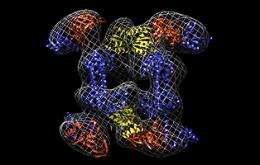Extremophile Yields a Key Cog in Life's Protein Factory

(PhysOrg.com) -- Peering at single molecules within an organism that makes its home near thermal vents, Yale University scientists have discovered the structure of a key player in the creation of protein-making factories in humans.
In the Sept. 11 issue of the journal Science, Susan Baserga, professor of molecular biophysics and biochemistry, genetics, and therapeutic radiology and her colleagues describe the elusive structure of an RNA and protein enzyme essential to making ribosomes, which churn out the proteins that carry out most of life’s functions. Malfunctions of this process have been implicated in cancer and as well as in rare genetic disorders that cause infertility and childhood cirrhosis.
Ribosomes carry out the essential business of translating the information encoded in DNA into proteins. The makeup of one of the key players in the process of making ribosomes, the RNA-protein enzymes called box C/D small ribonucleoproteins, had been unknown. Scientists were eager to describe the complex, which is so important to life it is conserved in organisms as diverse as yeast and humans, and even in extremophiles in the domain Archaea.
Baserga’s team decided to look at the archeon, Methanocaldococcus jannaschii, a microbe so hardy it survives in Antarctic ice and boiling thermal vents at the bottom of the ocean. Using single-particle electron microscopy, the research team was able to see that the RNA and protein enzyme was unexpectedly composed of two RNAs and 4 sets of proteins.
“It looks like a wheat thin with feet,” she said. “When you can discern structure, you can often figure out function.”
The structure of this RNA-protein enzyme is just one piece of the puzzle for understanding how the many factors that contribute to making human ribosomes come together at the right time and place. Mutations in other factors that make ribosomes can disrupt sperm production in men or lead to a rare form of cirrhosis. Also, because ribosome production is central to cell growth and division, it is routinely used as a marker to stage cancer progression.
“If you are a cancer cell, you need as many ribosomes as you can get,’’ Baserga said.
Baserga said her lab is already using the findings of this study to further understand how this enzyme is essential to the creation of ribosomal RNA.
Lead researcher on the Science paper was Franziska Bleichert of Yale. Vinzenz M. Unger was the other Yale author of the paper, which included contributors from North Carolina State and Harvard.
Provided by Yale University (news : web)
















